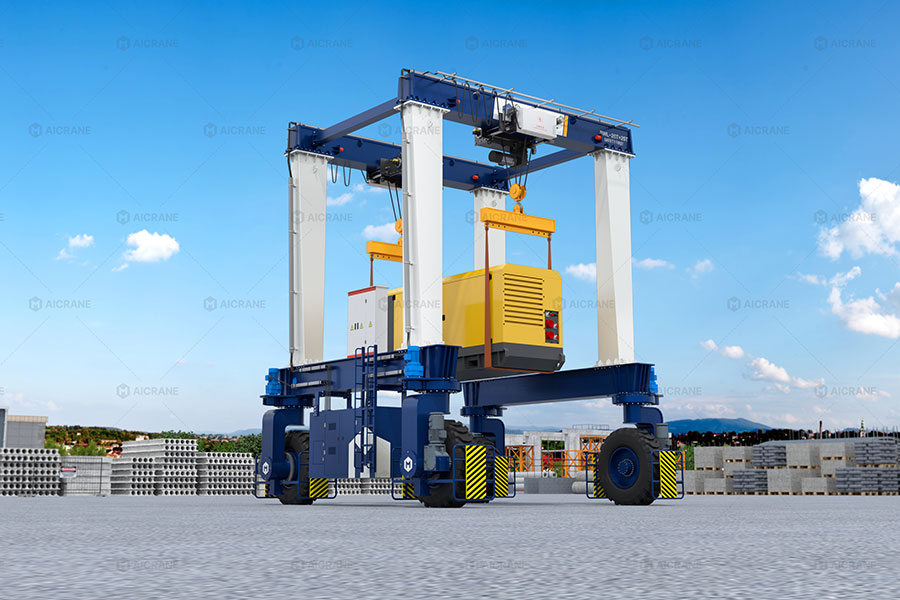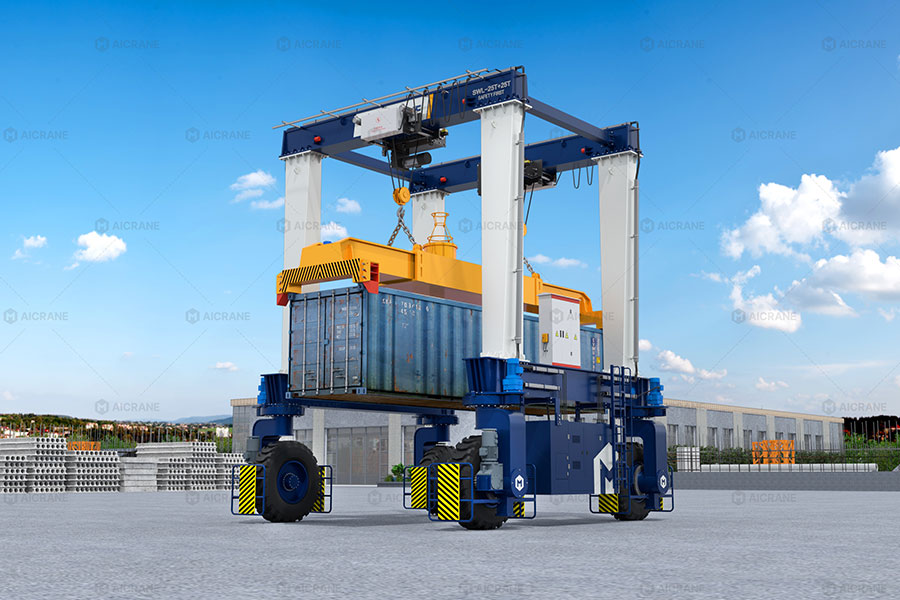Rubber Tyred Gantry (RTG) cranes are among the most versatile and widely used cranes in a range of industries, particularly in container handling, port operations, and heavy-duty lifting. These cranes are designed for efficiency and flexibility, with the ability to move across different terrains while handling large and heavy loads. Customizing the specifications of an RTG crane to meet the unique demands of a specific industry can significantly improve operational efficiency, reduce downtime, and enhance safety. In this article, we will explore the key factors involved in customizing rubber tyred gantry crane specification for different industries.

1. Understanding Industry-Specific Needs
Before diving into the technical specifications, it’s important to understand the specific needs of the industry in question. Every industry has its own unique set of requirements when it comes to lifting equipment. For instance:
-
Port and Container Handling: The primary function of an RTG crane in ports is to stack and move containers efficiently. These RTG container cranes need to be highly maneuverable and capable of handling containers of varying sizes and weights.
-
Construction and Heavy Lifting: In construction, RTG cranes are often used to lift heavy building materials, such as steel beams, concrete components, and machinery. Cranes in this sector must have a high lifting capacity and be adaptable to various job sites.
-
Steel Mills and Manufacturing Plants: In industries like steel mills, where materials are heavy and sometimes irregularly shaped, RTG cranes must have enhanced load stability and the ability to handle materials in a confined space.
-
Shipyards and Marine Applications: In shipyards, RTG cranes are frequently used for lifting and transporting large components of ships, such as hulls, engines, and other equipment. The crane’s lifting height and load capacity need to be designed to handle heavy marine parts.

2. Key Customization Factors
The customization of an RTG crane for a specific industry involves tailoring several key specifications to meet the unique requirements of that industry. These factors include lifting capacity, span, lifting height, mobility, and safety features.
a. Lifting Capacity
The lifting capacity is one of the most important factors when customizing an RTG crane. In industries like port handling, lifting capacity must be high enough to handle large containers (usually up to 50 tons), while in steel mills or construction sites, the lifting capacity may need to be much greater, sometimes reaching up to 100 tons or more.
-
Ports and Container Handling: RTGs used in port terminals are often required to handle 20-40-foot containers, so a typical lifting capacity in this scenario is between 35 tons to 50 tons.
-
Heavy Lifting Industries: For construction or steel mills, lifting capacities may need to be customized upwards, especially if the heavy duty gantry crane will be used to handle larger and heavier loads, such as steel beams, concrete parts, or large industrial machinery.
-
Shipyards and Marine Applications: RTGs used in shipyards may need to have an even higher lifting capacity to move heavy components like ship hulls or engines. For such operations, lifting capacities of 100 tons or higher may be required.
b. Span
The span of the crane refers to the distance between the center of the wheels on each side of the crane. This factor is crucial in determining the range of movement the crane can achieve in different applications.
-
Ports and Container Handling: In container terminals, the span is critical for accessing multiple containers stacked in rows. The typical span is designed to accommodate the standard container dimensions, which are usually between 12 meters to 20 meters. However, if the port is handling larger containers or special cargo, the span may need to be adjusted accordingly.
-
Construction and Heavy Lifting: In the construction sector, the span can be customized to accommodate wider work areas or greater distances, especially in large construction sites. A larger span helps in maneuvering over a wider range of materials, reducing the need for additional lifting equipment.
-
Steel Mills and Manufacturing Plants: Steel mills and other manufacturing facilities often work in more confined spaces. The span may need to be customized to ensure that the RTG crane can maneuver around heavy machinery, narrow aisles, and tight spaces.
-
Shipyards: In shipyards, where large parts need to be moved across the yard, the span of the crane can vary, often requiring adjustments to reach parts of ships that are spread across wide areas.
c. Lifting Height
The lifting height is another vital specification, particularly when lifting objects stacked at significant heights. In port operations, lifting height is particularly important for stacking containers on top of one another.
-
Ports and Container Handling: The lifting height should be sufficient to handle containers stacked up to 3 or 4 high. Typically, lifting heights of 15 to 40 meters are required for this purpose.
-
Construction and Heavy Lifting: In construction, the required lifting height may vary depending on the type of project. For example, lifting concrete beams, large machinery, or steel components could require cranes with adjustable heights or extended lifting capabilities, usually ranging from 10 meters to 30 meters.
-
Steel Mills and Manufacturing Plants: In these industries, lifting height may be needed to lift materials that are stored at great heights or to move materials over tall machinery, requiring a lifting height of around 20 meters or more.
-
Shipyards and Marine Applications: Shipyards often require high lifting heights, especially when lifting ship components, which could be very tall. Lifting heights for such cranes typically range from 25 to 50 meters.
d. Mobility and Steering Options
RTG cranes are known for their mobility, but how they move and navigate can be customized for specific industrial needs.
-
Ports and Container Handling: RTGs used in container handling often require highly maneuverable cranes that can turn in tight spaces. Steering options can include 4-wheel, 8-wheel, and hybrid steering, allowing the moveable gantry crane to operate in narrow aisles between container stacks and on uneven surfaces.
-
Construction and Heavy Lifting: In construction, maneuverability may be less of a priority than stability and load capacity, especially if the crane needs to move over rough terrain. Customizing the steering mechanism to suit the job site can ensure optimal performance.
-
Steel Mills: Steel mills typically use RTGs in confined spaces, so the crane must be able to navigate tight areas and move materials without disrupting the production process. A tighter steering radius and more agile wheel configurations may be necessary.
-
Shipyards: For shipyards, the crane’s mobility must be able to cover large, expansive areas with high precision. This typically requires customized steering that allows for easy movement along the large docks and ship construction areas.
e. Safety Features
Every industry has its own set of safety requirements, and these must be considered when customizing an RTG crane. These include features like anti-collision systems, load monitoring, and emergency stop functions.
-
Ports and Container Handling: Anti-collision sensors, automatic load monitoring, and emergency stop functions are critical in busy port environments to prevent accidents due to high traffic and narrow spaces.
-
Construction and Heavy Lifting: In construction sites, RTGs may need to operate around other equipment and personnel. Adding safety features like warning lights, alarms, and barriers can prevent accidents and improve safety on-site.
-
Steel Mills and Manufacturing Plants: In steel mills, where high temperatures and hazardous materials are common, safety features such as fire-resistant cables, heat-resistant coatings, and overload protection are crucial.
-
Shipyards: Shipyards are dangerous environments with numerous moving parts and workers. RTG cranes in these areas must have advanced safety features such as automatic load monitoring, emergency alarms, and anti-sway systems to prevent accidents.
3. Other Considerations for Customization
-
Control Systems: Customizing the control system of an RTG crane can greatly improve operator efficiency. Options like remote control, automatic positioning, and advanced safety monitoring systems can be tailored for specific tasks.
-
Energy Sources: Depending on the location and environmental regulations, you may need to consider whether a diesel-powered, hybrid, or fully electric RTG crane is the best fit for your industry.
-
Maintenance and Durability: RTGs in heavy-duty applications require durable components and easy maintenance access. Custom specifications for durability and the ability to withstand harsh environmental conditions (such as extreme temperatures or corrosive materials) are essential.
4. Conclusion
Customizing the specifications of a Rubber Tyred Gantry crane for a specific industry is crucial to achieving maximum efficiency, safety, and productivity. By considering factors like lifting capacity, span, mobility, and safety features, industries can ensure that their RTG cranes are fully suited to their unique needs. A well-tailored RTG crane will not only meet operational demands but also contribute to reduced maintenance costs, improved safety standards, and higher overall performance. Therefore, businesses must work closely with crane manufacturers and suppliers to ensure the design and configuration meet all necessary specifications for their specific applications.